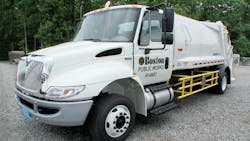New city ordinances are requiring trucks to protect cyclists and pedestrians from underride accidents
In 2012, the City of Boston launched a bike-share program. But with the increased popularity of cycling came an increase in fatal accidents—four in one year compared with only one in 2011. Most of the fatalities involved crashes with large vehicles—either trucks or buses.
Boston responded by testing the effectiveness of side guards installed on city vehicles. The intent was to reduce injuries and fatalities by installing a device that prevents pedestrians and cyclists from falling beneath the truck.
These types of accidents tend to occur in urban areas where trucks are required to operate in areas containing a high percentage of bicycle and pedestrian traffic. Many of these accidents occur as the truck is attempting to make a turn.
Accidents declined during the test period, leading Boston to pass a city ordinance making them mandatory. The ordinance, which took effect in May 2015, requires side guards, convex mirrors, crossover mirrors, and safety decals on all new contracts with the City of Boston on trucks with gross vehicle weight ratings above 10,000 pounds.
“In 2013, we launched our pilot program with $35,000,” Kris Carter, co-chair of the Mayor’s Office of Urban Mechanics, said at the recent Insurance Institute for Highway Safety’s Underride Roundtable (see May TBB, Page 17). “We looked at a fleet of 200 vehicles, focusing on trucks that were 2005 models or newer—ones that would have some service life left. It was a mix of trucks, including snowplow, platforms, and refuse trucks of different sizes.
“We contracted out to a couple of shops. From the fleet manager’s perspective, the guards had to allow the trucks to mount curbs and to provide relatively easy access to any hydraulic components behind the guard.”
The program came up with two designs—a rail guard and a mesh guard. J C Madigan Inc, a truck equipment distributor in Lancaster, Massachusetts, was one of the installers that the City of Boston turned to during that early period. The company fabricated and installed both designs, with the rail guard proving more desirable.
Carter says his team spent a year talking with mechanics and drivers and reviewing operations. And while the initial focus was on city trucks, a bicycle fatality with a private refuse truck at the end of 2014 led the city to consider broadening the scope of the requirements.
“The mayor wanted the program expanded to include contract trucks that do business with the city,” Carter said.
Other cities are beginning to require the trucks they buy to be equipped with side guards. Like Boston, New York City passed a similar ordinance last year. The issue is gaining traction in other cities as well, including San Francisco, Portland, Chicago, and Washington DC.
New York requirements
New York is another city to require side underride guards. The city passed a law last year that requires all municipal trucks to have side guards by 2024. The law also applies to trucks operated by waste haulers who do business with the city.
New York City has 28,000 vehicles, of which about 4,500 are considered candidates for side guards, according to Jack Graczyk, director of Fleet Services for New York City. He manages the side guard program, in particular the installation of guards on existing trucks. Speaking at the recent IIHS underride roundtable May 5, Graczyk said the city had retrofitted 365 vehicles.
“Tractor trailers stay on the highways. We don’t have a problem with them.” Graczyk said. “The pedestrian/bike fatalities that we have experienced have been with straight trucks. Guards are one of the easiest ways to save lives in congested areas. The speed limit in New York City is 25 mph, so speed isn’t the issue. We need to fill the gap between the cab and the rear axle, and it doesn’t take much to do it.
“We did a pilot study of 240 trucks—10% of the eligible fleet. We did that study to try to get as many types of vehicles as possible. From box trucks to rear loaders. We did those 240 trucks and started learning from them.
“If this works with waste hauling trucks, why not expand it to food delivery and other types of trucks that operate within the city and, hopefully, others within the state?”
In search of side guards
Early in trial period, municipalities had difficulty finding the side guards they envisioned.
“When we started our pilot, I was looking for anyone who did side guards,” Graczyk said. “I had a real difficult time finding anything. Then other companies began noticing. We began getting approached by people. As this market is expanding, there are more manufacturers and installers who are seeing this as a potential revenue source.”
Boston had a similar experience. With no side guard manufacturing companies in sight, the city looked to local truck equipment companies to meet their needs. Given the variety of trucks in the fleet of a large city, it quickly became apparent that one size would not fit all.
What’s important
New York City had had operational and engineering concerns as the side underride guard program began.
“Functionality of the trucks was a big deal,” Graczyk said. “For example, if you want to put a guard on the side, you will not be able to get to the fuel tanks or batteries as easily. Operational people will push back and say that they don’t want the guards. Or maybe you have a ladder, and you need to put a guard there. How do you combine the ladder and the guard? We are going back and forth. What are the operators saying? What technologies are available to us? And what capabilities do our installers have?
“And the big problem is that no two trucks are going to be the same. We have 20 different types of garbage trucks out there. There are different types of box trucks, different rack trucks. I’m happy when I can find five trucks that are clones of one another because then I can say ‘install the other four the same way.’ But that’s rarely the case. Every truck is a different story, and every truck requires a different approach. Ultimately we will get to the point where we have retrofitted most of them, but we aren’t at that point yet. We are getting the experience now so that we will know exactly how to approach each type of truck. We need to get more manufacturers involved.”
Making everyone happy
With the new city ordinance in place, the objections from operational personnel carry less weight. Even so, fleet managers still would like to balance both viewpoints—having guards that meet the requirements of the ordinance with minimal impact on the day-to-day functionality of the trucks.
Traditional locations of equipment are changing. If the guard has to go in a specific location, where can the ladder go? Can a guard be designed for quick removal?
Right after ladders (as problems for guard installations) are toolboxes. Graczyk said he thought about a guard that can be removed quickly to provide access to the toolbox. But he also wondered if it’s possible to design toolboxes that double as side underride guards.
“We have some heavy-duty tow trucks that have toolboxes with three doors, all across the bottom, that fill the gap,” he said.
How to comply
After passing its ordinance last year, Boston posted a YouTube video on how to comply. Key requirements:
• The guard cannot extend beyond the width of the truck.
• It cannot be more than five inches inboard from the width of the truck body.
• The bottom edge of the guard can be no more than 21.5 inches above the ground.
• The upper edge of the guard cannot be more than 14 inches below the bottom of the truck body.
• The guard cannot be more than 12 inches from the outer edge of the tires.
• The guard is not allowed to deflect more than six inches.
• A warning label must go on the guard to tell cyclists and pedestrians to avoid the truck’s blindspots.
In addition, Boston requires the truck to be equipped with convex mirrors to guard against side blind spots and crossover mirrors the combat front blind spots. The city’s inspection process includes these mirrors in its inspection.
• The convex mirrors must make three-foot cones visible to the driver anywhere along the side of the truck from the mirror rearward.
• The crossover mirrors must enable the driver to detect cones when the cones are placed in front of the truck’s front bumper.
Trucks that successfully pass the inspection will receive a sticker for its windshield.
Economies of scale
Cost of the initial guards ranged in price between $1,000 and $1,800 initially, Carter said in his presentation at the IIHS Underride Roundtable. Early on, these were prototypes that were custom-made.
Fleet managers would like for there to be more standard guard designs and want installation of side guards to be integral with the truck manufacturing process.
“If we can get trucks that already have these on there, that would be huge for us,” Carter said.
The City of Boston has now retrofitted the majority of its trucks with model years 2005 or newer. The only exceptions are the large dumps used for snow removal that are exempt from the sideguard mandate, but they are equipped with additional mirrors as required.
Carter expects side guards to become increasingly common as compliance in Boston increases and the idea becomes more popular in other cities.
Boston gradually ramped up its enforcement of the ordinance, beginning with the process of letting people know about it.
“Communication wrapped up this past winter,” he said. “We sent emails out to virtually anyone who contracts with the city. The next step is punitive measures. The ordinance allows for inspection of vehicles that are on city property or conducting city work. Inspectors are issuing soft warnings at this point, but the ordinance also includes a structure of fines. Three violations can cause the city contract to be voided.”
Carter and Graczyk both are looking for ways to reduce costs and simplify installation.
Initially Boston and New York had difficulty finding suppliers, and they relied on custom guards built locally. Graczyk said his group now uses outside installers as well as internal shop personnel who, as the department becomes more experienced, design and install their own.
Carter hopes demand for guards will spread statewide, eventually enabling compliance to become part of the Massachusetts motor vehicle inspection. To that end, Boston is building a coalition of cities and other groups to pressure the legislature to increase interest at the state level.
Many of the side guards currently going on Boston trucks are composite panels made in Canada. One of the other speakers at the IIHS Underride Roundtable mentioned the availability of side guards available in kit form that are manufactured in the UK.
As demand increases, so does interest in the truck equipment industry.
“We are excited about the conversations being had with OEMs to begin offering models of the production line with these features,” Carter said.
Boston also is working with the state DOT with regard to procurement strategies.
“This gives us another lever.” he said. “If we can get hospitals and universities onboard, we can get this extended to about half of the largest employers in Boston. Those talks are going well. People are interested in saving lives.” ♦
About the Author
Bruce Sauer
Editor
Bruce Sauer has been writing about the truck trailer, truck body and truck equipment industries since joining Trailer/Body Builders as an associate editor in 1974. During his career at Trailer/Body Builders, he has served as the magazine's managing editor and executive editor before being named editor of the magazine in 1999. He holds a Bachelor of Journalism degree from the University of Texas at Austin.


